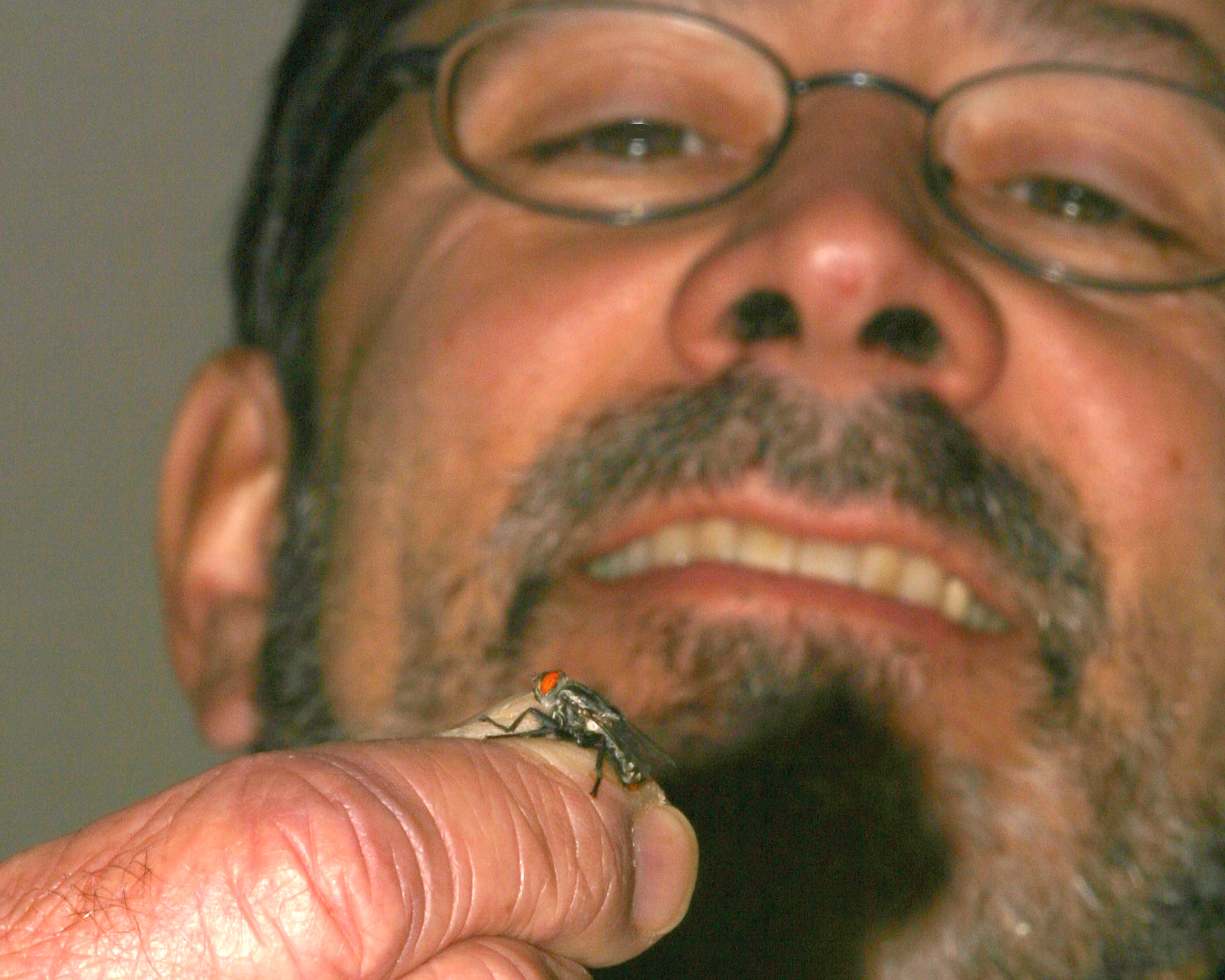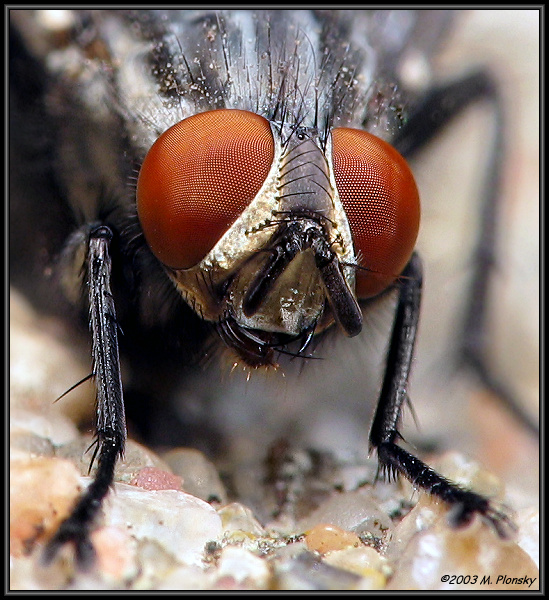Dr. Karl H. Joplin
Associate Professor
Back to Biological SciencesSnail Mail:Department of Biological SciencesPhone: (423) 439-6921 Fax: (423) 439-5958 email: joplin@mail.etsu.edu |
|
![]()
Teaches:
General Biology, Entomology, Molecular Biology and Recombinant DNA Lab.
Current Research Programs:
LORD OF THE FLIES?
 |
Well, probably not, though I have found that flies are a diverse group of organisms that have qualities that make them a good model system to study development and gene expression. The broad scope of my research is to study the transcriptional control of gene expression during development and to correlate these changes to cellular and physiological functions. Diapause is an aspect of their life cycle that insects use to survive winter conditions. As such it has similarities to other interrupted life stages such as the dauer larval stage of Caenorhabditis elegans, hibernation of vertebrates, sporulation of bacteria and yeast, seed dormancy of plants and perhaps even the Go stage of the cell cycle. The flesh fly, Sarcophaga crassipalpis, is an attractive organism for this study because the developmental decision to enter into either diapause or to continue development is a circadian-gated window that can be experimentally controlled by manipulating daylength. My research is opening new approaches to this area by identifying specific genes being expressed during diapause. |
![]()
 |
Molecular Aspects of Insect Development: DIAPAUSEThe characteristics unique to the alternative developmental state of diapause (morphological stasis, increased thermotolerance, unique hormonal titers, metabolic cycles and cellular changes) are an indication that the continuous developmental program is switched off and an alternative (diapause) genetic program is initiated. I have described protein synthesis cycles occurring in phase with metabolic and juvenile hormone cycles found in diapausing pupae of Sarcophaga (Joplin and Denlinger, 1989). I used pulse-labeling and large format 2-D gel electrophoresis to demonstrate that numerous brain proteins are uniquely expressed during diapause (Joplin et al., 1990). An examination of the cellular ultrastructure of the ring gland, hormonal cells involved in the production and release of ecdysone and juvenile hormone, demonstrated a unique cellular organization during diapause (Joplin et al., 1993). Identification of these diapause-specific proteins in the brain would greatly expand the scope of research into the genetic control of not only diapause, but developmental states in general. Diapause, as an optional developmental state, is an example of a genetic response to an environmental cue that stops continual development and initiates an alternative developmental program. Conceptually this is similar to the Go state of the cell cycle. I am developing S. crassipalpis from its current status as a physiological model of diapause into a model system of developmental gene expression. We identified 4 diapause-up-regulated clones, 7 diapause-down regulated clones and 8 clones expressed equally in both (Flannagan et al. 1997). Sequencing has identified homology to stress response genes, cell cycle control genes and DNA repair genes. Further characterization of these clones to define their tissue and stage expression, and their genomic organization is an ongoing project. I have used the technique of differential display of eukaryotic mRNA to quantify the changes occurring during diapause. The results suggested that between 500-1000 genes maybe involved in diapause establishment and control. We have used a heterologous microarray of diapause/nondiapause mRNA from the heads of pupae as probes against a Drosophila microarray of 12,000 duplicate genes. The results supported the differential display estimations with 351 candidate diapause up-regulated genes and 254 candidate diapause down-regulated genes. My undergraduate and graduate students have been looking at these candidate genes and verifying the results using RT-PCR. Currently about 24 genes have been verified by RT-PCR. |
![]()
Organismal Response to Environmental Stress: HEAT SHOCK PROTEINS
Another aspect of my research explores the
physiological trait of increased thermotolerance in diapausing pupae. This
area examines the physiological changes of organisms in relation to the
control of gene expression as they respond to their environment. I have
established that the major stress-induced protein, hsp 70, is
expressed as different isoforms during development in the brain and in other
tissues, thus showing that heat shock protein expression in Sarcophaga
is more complex than that described in Drosophila (Joplin and
Denlinger, 1990). I've further shown that the heat shock proteins are
expressed in response to recovery from cold shock in Sarcophaga and other
insects (Joplin et al., 1990; Yocum, et al., 1991; Lee, et al., 1995, Joplin
and Moore, 1998). Heat shock expression is an established model system of
gene expression but less is known concerning its effect on the physiology of
organisms during stress. Physiological responses to stress are currently
being investigated using freshwater invertebrates and vertebrates as they
respond to heat shock, heavy metals and organic pollutants. The
physiological responses of model systems such as Sarcophaga crassipalpis
as, the gypsy moth, Lymantria dispar, and the freeze tolerant
goldenrod gall fly, Eurosta solidaginus are also being examined.
Isolation of heat shock genes from various organisms using PCR will be used
to determine their involvement in other stress responses. These genes could
have potential commercial value if stress genes are induced in response to
many environmental insults, such as pollution.
![]()
Circadian Activity and Behavior
A novel research direction that I have started is the influence of stress on circadian activity. We have examined the effects of acute heat shock and cold shock treatments on the circadian activity of S. crassipalpis (Joplin and Moore, 1998). Our results demonstrate that stress can have a profound effect on the expression and response to environmental cues at the physiological level. The most recent results suggest that a higher order of activity can emerge from interactions due to increasing individual density in a chamber. This may have interesting implications for the study of social, rhythmic and chaotic behavior patterns in organisms.
In collaboration with Dr. Darrell Moore our lab has explored the affects of development on behavior. Flesh fly males are territorial. They can be seen evenly spaced on fence lines and railings in the summer. They appear to fly out to investigate anything flying by (including small pebbles tossed along the fence line). If it is a female they mate, otherwise they go back to their spot. They appear to only guarding a space, since there is no food, or larvaposition site, that is not needed for the female until another week. It is difficult to study this system and we asked if they show a similar behavior in the lab.
Our first study showed that males were spread out, while females were slightly more clumped than random. This only occurs during the light phase, since males show a female distribution during the dark phase. There is also no circadian pattern to this behavior, suggesting that males need to see each other (Paquette, et al. 2009). We are now studying the acutal behavior of males and seeing that males have an ontogeny of behaviors, particularly with respect to aggressive behaviors.
![]()
Selected Papers:
2008 Paquette C, KH Joplin, E Seier, J Peyton, D Moore. Gender-specific differences in spatial behaviour in the flesh fly, Sarcophaga crassipalpis. Physiological Entomology 33:382-388.
2008 Darrell M., M. Helfgott, Joplin KH, Karsai I, Knisely J, Seier E. The SYMBIOSIS Project: Current and Future Needs (in press)
2008 J. Knisley, I. Karsai, A. Godbole, M. Helfgott, KH Joplin, D Moore, E Seier. The SYMBIOSIS Project: The Integration of Biology, Mathematics, and Statistics into a Introductory Quantitative Biology Sequence (in press)
2008 Joplin KH, E Seier, M Helfgott, I Karsai, J Knisley, D Moore and HA Miller, III.SYMBIOSIS: An Integration of Biology and Statistics at the Freshman Level: walking together instead of on opposite sides of the street. (in press)
2008 Govett A, HA Miller III, D Moore, E Seier, KH Joplin, A Godbole, J Knisley, M Helfgott, and I Karsai. Adventures in Assessment: How to Evaluate a New Integrated Quantitative Biology Program (in press)
2006 Knisley J, LL Glenn, K Joplin, and P Carey*. Artificial Neural Networks for Data Mining and Feature Extraction. In: Quantitative Medical Data Analysis Using Mathematical Tools and Statistical Techniques (D. Hong and Y. Shyr Eds.), World Scientific Publications, Singapore.
2002 Seier E, D Moore, and KH Joplin. Exploratory Tools for Comparison of Activity Time Series. Proceedings of the American Statistical Association, Biometrics Section [CD-ROM], Alexandria, VA: American Statistical Association.
2001 Shanks N and KH Joplin. Behe, Biochemistry, and the Invisible Hand. Philo 4:53-66.
2000 Shanks N and KH Joplin. Of Mousetraps and Men: Behe's Biochemical Conundrum. Reports National Center for Science Education 20:25-30.
1999 Joplin KH and DM Moore. Effects of environmental factors on circadian rhythms in the flesh fly, Sarcophaga crassipalpis. Physiological Entomology 24: 64-71
1998 Shanks N and KH Joplin. Redundant Complexity: A Critical Analysis of Intelligent Design in Biochemistry. Philosophy of Science 66: 268-282
1998 Yocum GD, KH Joplin, DL Denlinger. Developmental expression of 13 and 23 kDa small heat shock proteins in relationship to pupal diapause in the flesh fly Sarcophaga crassipalpis. Insect Biochemistry and Molecular 28: 677-682.
1998 Flannagan RD, SP Tammariello, KH Joplin, RA Cikta-Ireland, GD Yocum and DL Denlinger. Diapause specific gene expression in pupae of the flesh fly, Sarcophaga crassipalpis. Proceedings National Academy Sciences 95:5616-5620.
1995 Denlinger, DL, KH Joplin, RD Flannagan, SP Tammariello, M-L Zhang, GD Yocum and K-Y Lee. Diapause-specific gene expression. In: Molecular Mechanisms of Insect Metamorphosis and Diapause. Ed. Suzuki, A., H. Kataoka and S Matsumoto. pp 289-297. Industrial Publishing and Consulting, Inc. Tokyo.
1995 Lee, RE Jr, RA Dommel, KH Joplin and DL Denlinger. Cryobiology of the freeze tolerant gall fly, Eurosta solidaginis: Overwintering energetics and heat shock proteins. Climate Research 5: 61-67.
1994 Yocum GD, J Zdarek, KH Joplin, RE Lee, DC Smith, KD Manter and DL Denlinger. Alteration of eclosion rhythm and behavior by low and high temperature stress in the flesh fly, Sarcophaga crassipalpis.. J. Insect Physiol. 40:13-21.
1994 Yocum GD, J Zdarek, KH. Joplin, RE. Lee, DC Smith, KD Manter and David L. Denlinger. Alteration of eclosion rhythm and behavior by low and high temperature stress in the flesh fly, Sarcophaga crassipalpis. J. Insect Physiol. 40:13-21.
1993 Joplin KH, DL Stetson, JG Diaz and DL Denlinger. Cellular differences in ring glands of flesh fly pupae as a consequence of diapause programming. Tissue and Cell 25:245-257.
1991 Yocum GD, KH Joplin and DL Denlinger. Expression of heat shock proteins in response to both heat and cold shock in diapausing pharate larvae of the gypsy moth, Lymantria dispar. Arch. of Insect Biochem. and Physiol. 18:239-249.
1990 Joplin KH, GD Yocum and DL Denlinger. Cold shock elicits expression of heat shock proteins in the flesh fly, Sarcophaga crassipalpis. J. Insect Physiol. 36: 825-834.
1990 Joplin KH, GD Yocum and DL Denlinger. Diapause specific proteins expressed by the brain during the pupal diapause of the flesh fly, Sarcophaga crassipalpis. J. Insect Physiol. 36: 775-783.
1990 Joplin KH and DL Denlinger. Developmental and tissue specific control of the heat shock induced 70 kDa related proteins in the flesh fly Sarcophaga crassipalpis. J. Insect. Physiol. 36: 239-249.
1989 Joplin KH and DL Denlinger. Cycles of protein synthesis during pupal diapause in the flesh fly, Sarcophaga crassipalpis. Arch. of Insect Biochem. and Physiol. 12:111-122.
![]()
Return to ETSU Biological
Sciences Home Page
Return to
ETSU Biological Sciences Faculty and Staff Home Page